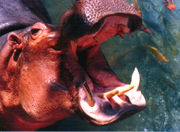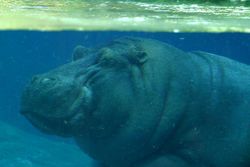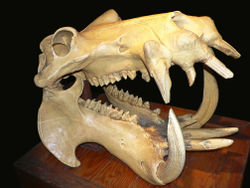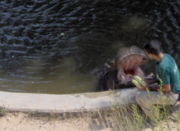Hippopotamus
2007 Schools Wikipedia Selection. Related subjects: Mammals
| iHippopotamus | ||||||||||||||
|---|---|---|---|---|---|---|---|---|---|---|---|---|---|---|
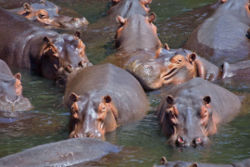 Pod of hippos, Luangwa Valley, Zambia
|
||||||||||||||
|
|
||||||||||||||
| Scientific classification | ||||||||||||||
|
||||||||||||||
|
|
||||||||||||||
| Hippopotamus amphibius Linnaeus, 1758 |
The Hippopotamus (Hippopotamus amphibius), from the Greek ‘ιπποπόταμος (hippopotamos, hippos meaning "horse" and potamos meaning "river"), is a large, plant-eating African mammal, one of only two extant, and three or four recently extinct, species in the family Hippopotamidae.
Characteristics
Hippopotamuses (hippopotami is also accepted as a plural form by the OED), also sometimes called hippos, are gregarious, living in groups of up to 40 animals, called a pod, herd, school or bloat. A male hippopotamus is known as bull, a female as cow, and a baby as calf. A hippo's lifespan is typically 40 to 50 years. Female hippos will reach sexual maturity at 5 to 6 years, and have a gestation period of 8 months.
Hippos average 3.5 metres (11 ft) long, 1.5 m (5 ft) tall at the shoulder, and weigh from 1500 kg to 3200 kg (3,300 to 7,000 lb). They are approximately the same size as the White Rhinoceros, and experts are split on which is the next largest land animal after the elephant. Male hippos appear to continue growing throughout their lives, whereas the females reach a maximum weight at around the age of 25. Females are smaller than their male counterparts, and normally weigh no more than 1500 kg. The value given above of 3200 kg is often quoted as being the upper limit of weight for a male hippo. However, larger specimens than this have been documented, including one which weighed about 10,000 lb (4,500 kg) and measured about 16 feet (5 m) long. Even though they are bulky animals, hippopotamuses can run faster than a human on land. There are estimates of their running speed varying from 30 km/h (18 mph) to 40 km/h (25 mph), or even 50 km/h (30 mph). The hippo can maintain these higher estimates for only a few hundred metres or yards.
The eyes, ears, and nostrils of the hippo are placed high on the roof of the skull. This allows them to spend most of the day with the majority of their body submerged in the waters of tropical rivers to stay cool and prevent sunburn. For additional protection from the sun, their skin secretes a natural sunscreen substance which is red-colored. This secretion is sometimes referred to as "blood sweat," but it is not actually blood, nor sweat. This secretion starts out colorless and turns red-orange within minutes, eventually becoming brown.
There are two distinct pigments that have been identified in the secretions, red and orange. The two pigments are highly acidic compounds. They are known as red pigment hipposudoric acid and orange one norhipposudoric acid. The red pigment was found to inhibit the growth of disease-causing bacteria, lending credence to the theory that the secretion has an antibiotic effect. The light absorption of both pigments peaks in the ultraviolet range, creating a sunscreen effect. Hippos all over the world secrete the pigments so it does not appear that food is the source of the pigments. Instead, the animals may synthesize the pigments from precursors such as the amino acid tyrosine. (Saikawa, et al., 2004)
As indicated by the name, ancient Greeks considered the hippopotamus to be related to the horse. Until 1985, naturalists grouped hippos with pigs, based on molar patterns. However evidence, first from blood proteins, then from molecular systematics, and more recently from the fossil record, show that their closest living relatives are cetaceans – whales, porpoises and the like . Hippopotami have more in common with whales than they do with other artiodactyls (even-toed ungulates), such as pigs. Thus, the common ancestor of hippos and whales existed after the branch-off from ruminants, which occurred after the divergence from the rest of the even-toed ungulates, including pigs. While the whale and hippo are each other's closest living relatives, their lineages split very soon after their divergence from the rest of the even-toed ungulates.
Range
Before the last Ice Age, the hippo was wide-spread in North Africa and Europe, and it can live in colder climates on the condition that the water does not freeze during winter. The species was common in Egypt's Nile region until historic times but has since been extirpated. Pliny the Elder writes that, in his time, the best location in Egypt for capturing this animal was in the Saite nome ( N.H. 28.121); and the animal could still be found along the Damietta branch after the Arab Conquest ( 639). Even on the island of Malta, at Għar Dalam (the Cave of Darkness), bone remains of hippopotamuses have been found, dated to about 180,000 years old. Hippos are still found in the rivers and lakes of Uganda, Sudan, Kenya, northern Democratic Republic of the Congo and Ethiopia, west to Gambia as well as in Southern Africa (Botswana, Republic of South Africa, Zimbabwe, Zambia). A separate population is in Tanzania and Mozambique.
Behaviour
Hippos are highly territorial; a male hippo often marks his territory along a riverbank from which to draw in a harem of females, while defending it against other males. Male hippos challenge one another with threatening gapes. Their canine teeth are 50 cm (20 inches) long, and it uses its head as a battering ram, especially against rival males while fighting over territory. Since their habitat is often encroached upon by farmers and tourists, and because they are so territorial, the hippopotamus is considered the most dangerous animal in Africa. They kill crocodiles and lions, and are even responsible for more human deaths than any other African animal. The hippo does not hunt humans, but defends its own territory vigorously.
Hippos are usually found in shallow water, and rarely come out of that depth. Most hippos that look as though they are floating are standing or lying on the bottom. They come on to land to feed, mostly at night, consuming as much as 50 kg (110 lb) of vegetation per day. They have been known to occasionally scavenge meat from animals found near their range, but hippos are not significantly carnivorous.

Adult hippos are not generally buoyant. When in deep water, they usually propel themselves by leaps, pushing off from the bottom. They move at speeds upto 8 km/h in water. Young hippos are buoyant and more often move by swimming, propelling themselves with kicks of their back legs. One hippo calf survived after being pushed out to sea during the tsunami generated by the 2004 Indian Ocean earthquake and was rescued on a nearby island.
Baby hippos are born underwater at a weight between 25 and 45 kg (60−110 pounds) and must swim to the surface in order to take their first breath. The young often rest on their mothers' backs when in water that is too deep for them, and swim underwater in order to suckle.
Adult hippos typically resurface to breathe every 3–5 minutes. The young have to breathe every two to three minutes. The process of surfacing and breathing is automatic, and even a hippo sleeping underwater will rise and breathe without waking. Hippos have been documented staying submerged for up to thirty minutes. A hippo closes its nostrils when it submerges.
Adult hippos are extremely hostile toward crocodiles, which often live in the same pools and rivers as hippopotami. This is especially so when hippo calves are around. Hippos also seem to empathize with the prey of crocodiles and have been known to stand guard over dead and dying antelope on river banks.
Extinction
Three species of hippos (family Hippopotamidae) became extinct within the Holocene on Madagascar, one of them as recently as about a thousand years ago. A dwarf species, Phanourios minutis, existed on the island of Cyprus but became extinct at the end of the Pleistocene. Whether this was caused by human intervention is debated (see Aetokremnos). In 2005, the population of hippos in Democratic Republic of the Congo's Virunga National Park had dropped to 800 or 900 individuals from around 29,000 in the mid 1970s, raising concerns about the viability of that population. This decline is attributed to the disruptions caused by the Second Congo War. The poachers are believed to be former Hutu rebels, poorly paid Congolese soldiers and local militia groups. Reasons for poaching include the belief that hippos are unintelligent, that they are a harm to society, and also for money—a three-tonne hippo is worth thousands of dollars. The sale of hippo meat is illegal, but black-market sales are difficult for WWF officers to track.
Conservation status and research
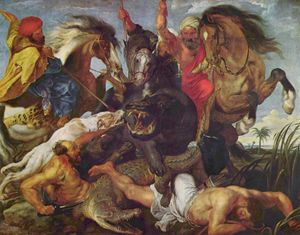
Five subspecies of hippos have been described based on morphological differences (H. a. amphibius, H. a. kiboko, H. a. capensis, H. a. tschadensis, H. a. constrictus; Lydekker 1915). However, the existence of these putative subspecies had not been tested by genetic analyses. A recent paper by Okello et al. (2005) does just that. Using mitochondrial DNA from skin biopsies taken from 13 sampling locations, the authors consider genetic diversity and structure among hippo populations across the continent. They find low but significant genetic differentiation among 3 of the 5 putative groups - H. a. amphibius, H. a. capensis, H. a. kiboko. If these findings are accurate, that would mean that common hippos in Kenya and Somalia (kiboko), southern Africa (capensis from Zambia to South Africa), and the rest of sub-Saharan African countries (amphibius) represent three distinct subspecies, with H. a. amphibus as the ancestral group. Okello et al. also find evidence that common hippos in Africa experienced a marked population expansion during or after the Pleistocene Epoch, which they attribute to an increase in water bodies at the end of this era. These findings have important conservation implications. Hippo populations across the continent are threatened by habitat loss and unregulated hunting. In addition to addressing these common threats, the genetic diversity of these three distinct subspecies will need to be preserved. The hippopotamus has been moved on to the IUCN Red List drawn up by the World Conservation Union (IUCN) in May 2006. This signifies that the common hippopotamus is now in serious danger of extinction.
Miscellanea
- Hippo seem to be aware of the presence of large bodies of water from some distance away. After the construction of the Blyde Canyon Dam in South Africa, a group of hippo walked up an access road for about 15 km and settled in the water of the new dam.
- Donna the Hippo, 55, is the oldest known hippo in captivity. Donna can be found at the Mesker Park Zoo in Evansville, IN.

